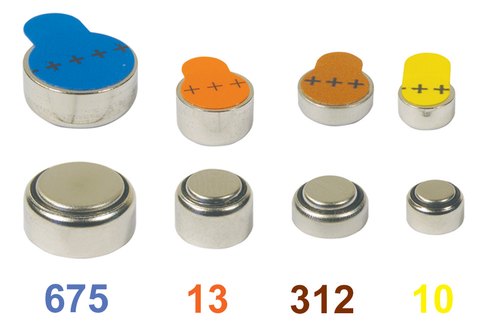Like any technological device, hearing aids run on batteries. Traditionally, most hearing aids used tiny “button” batteries that wearers had to change every few days to weeks. Now, though, many hearing aid models come with rechargeable batteries. When choosing a hearing aid, it’s a good idea to think through which battery type works best for you. Hearing aid devices, as distinguished from cochlear implants, may be classified as: class I devices and exempt from premarket review and clearance before marketing
Types of hearing aid batteries
Rechargeable batteries: Many of the latest hearing aid models come with rechargeable lithium-ion batteries. These batteries are usually recharged at night, when a hearing aid wearer takes out their hearing aids to sleep. So far, rechargeable batteries are generally only available for behind-the-ear styles of hearing aids.
Standard disposable batteries: Zinc-air button disposable batteries, also known as “button batteries,” are the other common option. Because zinc-air batteries are air-activated, a factory-sealed sticker allows them to remain inactive until it is removed. Once peeled from the back of the battery, oxygen will interact with the zinc in the battery and “turn it on.” To get the best performance from a zinc-air battery, wait about one minute after removing the sticker to fully activate before placing it in the hearing device. Replacing the sticker will not deactivate the battery, so once the sticker is removed, the battery will remain in an active state until the power is drained.
Zinc-air batteries remain stable for up to three years when stored in a room temperature, dry environment. Storing zinc-air batteries in the refrigerator has no benefits and could cause condensation to form under the sticker, which could reduce battery life prematurely. Traditionally hearing aid batteries were produced using trace amounts of mercury to assist with conductivity and stabilize internal components, but mercury is no longer used in hearing aid batteries.
Battery life for hearing aid batteries
Non-rechargeable hearing aid batteries can last anywhere from five to 14 days, based on a 16-hour day of wear. This is dependent upon the size of the battery and power needed by the hearing aid. Typically, smaller batteries have shorter battery life than larger ones.
The average lifespan of hearing aid batteries is as follows:
- Size 10 – three to seven days
- Size 312 – three to 10 days
- Size 13 – six to 14 days
- Size 675 – nine to 20 days
If you are experiencing shortened battery life, there may be an issue with the hearing device. In this case, you should consult your user manual or contact your hearing healthcare professional to make sure everything is working properly.
How to extend the life of a hearing aid battery
While there aren’t any foolproof ways to extend non-rechargeable battery life, these tips will ensure the power isn’t being wasted.
Turn the hearing devices off when not in use and leave the battery compartment door open overnight. Not only will this help keep battery power from being wasted, it will allow any moisture that has built up from the day’s use to evaporate overnight.
To get optimal performance from your batteries, always store them at room temperature. Heat exposure and humid environments such as a bathroom will shorten battery life. Also, batteries shouldn’t be carried loose in pockets, a purse or a backpack where they might come into contact with other metal objects like coins or keys that can short-circuit the hearing aid batteries.
How To Dispose Of Hearing Aid Batteries
The disposal of hearing aid batteries depends on the type of battery and if it contains mercury. Mercury-free battery options can be disposed of in household waste — to determine if your hearing aid batteries are mercury-free, refer to the packaging. Single-use batteries are now made of common metals deemed non-hazardous by the federal government and can be disposed of in your regular trash in all states except California, where it is illegal to throw away all types of batteries. All batteries in California must be taken to a Household Hazardous Waste disposal facility, a universal waste handler, or an authorized recycling facility.
If the battery package does not specify the battery is mercury-free, assume it is not safe to toss. These batteries should be recycled responsibility at a recycling center that accepts mercury-containing batteries.
One example of a brand that uses mercury in some of their products is PowerOne. PowerOne sells both mercury-free and mercury-containing batteries. Although they are a German company, they do sell their batteries to US vendors (typically audiology offices). Should you need a mercury-containing battery, ask your audiologist to obtain it for you.
Since some hearing aids do not operate well on mercury-free batteries, it is common for audiologists to carry both mercury-free and mercury-containing batteries. Hearing aids can also be sensitive to varying voltage readings. A perfectly good mercury-free battery may be read by the hearing aid as having a low voltage and cause the hearing aid to emit false “low battery” warnings or the hearing aid may shut itself down when battery levels briefly drop. This stems from mercury-free batteries having overall less stable voltage patterns. Battery manufacturers are improving their batteries every year to deal with these issues and hearing aid manufacturers are also changing how hearing aids monitor battery levels. However, there are many hearing aid users who find, at least for now, that mercury-containing batteries are a necessity.
Hearing aids that are more likely to need mercury-containing batteries include high-power hearing aids, hearing aids that take size 10 batteries, and older digital models.
ALSO READ: How To Dispose Of Old Glucose Meters






